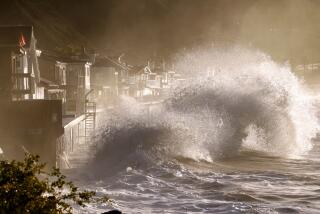El Nino May Skip This Year After All : Merchant Fleet Helps Monitor Temperatures
- Share via
One reason weather scientists are reevaluating their predictions of a new El Nino is because of changes in ocean temperatures detected by a fleet of 35 ocean-going tankers and cargo ships that work in conjunction with the Scripps Institution of Oceanography.
As the ships ply the major trade routes of the mid- and subtropics, they routinely drop sophisticated nine-inch probes that measure temperatures as they descend to 1,500 feet.
When it has finished its work in about 90 seconds, the probe ejects a small wirelike device that shoots to the surface, where it transmits data to the ship. In turn, the ship relays the information via satellite to an on-shore receiving station, where it is forwarded to Scripps in La Jolla. To ensure that the electronic data is accurate, the ships’ on-board computers record the information on tape.
The man who coordinates this dizzying array of numbers--up to 12,000 readings are made each year and tens of thousands have been made since the program began 20 years ago--is David Cutchin, Ph.D., a physical oceanographer at Scripps.
“The ships are probably the most reliable source of information of an existence of an El Nino,” Cutchin said, adding that the top layer of the ocean best reflects climatic changes in the atmosphere. Consistent monitoring of the upper warm-water layer provides not only important information about temperature, he said, but also data on changes in ocean currents (particularly around the Equator) and various anomalies such as circulation and temperature troughs.
For example, the readings derived from the ships have shown that, for the last month and half, temperatures in the tropical Pacific are normal and, in some cases, slightly cooler than usual. The only major exception to this, Cutchin explained, is a small area of slightly warmer water confined mainly west of the Galapagos Islands, situated on the Equator near Ecuador.
“The ocean is easier to observe. We can see the cumulative effect (of weather changes), and it is probably more reliable than anything else we have,” Cutchin said, who added that French scientists stationed in Tahiti help operate the program.
While today’s measurements show no signs of El Nino, Cutchin says it is almost impossible to make accurate long-range predictions. What that means, he said, is that, while he can’t rule out the possibility of El Nino occurring late this year, it seems unlikely unless tropical ocean temperature change significantly.
The ships, which give their services free, are provided with cases of probes, which cost $40 each. An average of about four probes a day are dropped in the major shipping lines according to a plan that subdivides sections of the sea, said Cutchin.
A year’s worth of probes costs about $480,000, which is covered by the federal government. Information generated by the readings is freely shared among scientists worldwide.
“The program is cost-effective . . . it would cost $10,000 a day for a research vessel to do this,” according to Cutchin. “Paying for the ship’s time would just kill you.”
More to Read
Sign up for Essential California
The most important California stories and recommendations in your inbox every morning.
You may occasionally receive promotional content from the Los Angeles Times.












